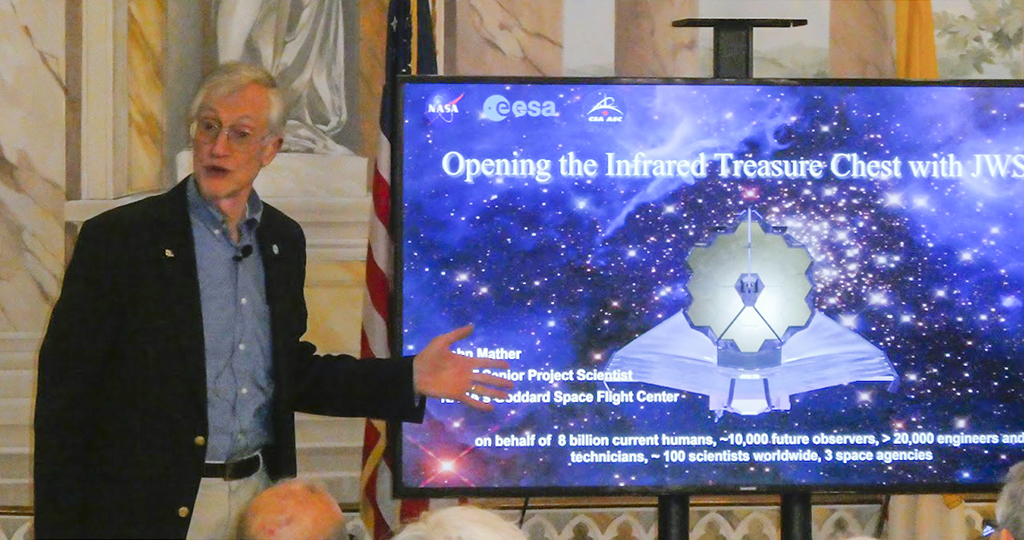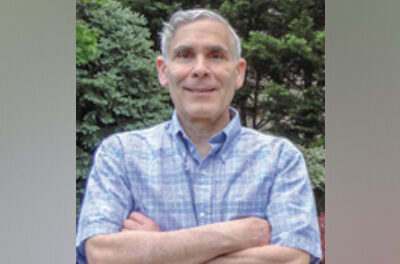
Nobel Laureate Describes Exciting Work on James Webb Space Telescope
By Nancy DeSanti, 1st Vice President-Programs

Credit: Sam Yothers
On January 29, 2023, Casa Italiana was the site of a talk by a Nobel Prize winner explaining the most exciting scientific research into the universe now taking place. Dr. John C. Mather spoke to an appreciative audience about his work as the senior project scientist for the James Webb Space Telescope (JWST), the most powerful space telescope ever built. The decades-long project has involved the work of 20,000 scientists, engineers, and computer programmers.
The AMHS program was co-sponsored by the Casa Italiana Sociocultural Center, and Dr. Mather’s talk was arranged by AMHS member Joe Novello, who was formerly a colleague of Dr. Mather at NASA.
Dr. Mather is a senior astrophysicist at the NASA Goddard Space Flight Center in Maryland and adjunct professor of physics at the University of Maryland’s College of Computer, Mathematical, and Natural Sciences. In 2007, Time magazine listed him among the “100 Most Influential People in The World.”
Dr. Mather is an astrophysicist, cosmologist and winner of the Nobel Prize in Physics in 2006 for his work on the Cosmic Background Explorer Satellite (COBE) with George Smoot. That work helped cement the Big Bang theory of the universe. He is also the senior project scientist for the James Webb Space Telescope, launched on December 25, 2021. Dr. Mather showed us some of its stunning images from deep space that are bringing us closer to a new understanding of worlds outside our solar system.
Recently, when the JWST captured a unique perspective of the universe, including never-before-seen galaxies described as glittering like diamonds in the cosmos, one research astronomer commented, “the stunning image quality of Webb is truly out of this world.”
The Nobel laureate called the James Webb Space Telescope “the most important work of my life.” The project will study the evolution of planetary systems and the ways they could support life. JWST is expected to observe galaxies at all stages of development, so that the result will be a complete picture of galaxy assembly from the epoch of first light through the present. As Dr. Mather aptly noted, “astronomers travel at the speed of imagination.”
As to whether he was nervous about the launch, he said, “No, not at all. We had a checklist of 700 items which we went over and over carefully. And it worked perfectly!” He said the JWST will be good for 20 years, until it runs out of rocket fuel.
He said he does not know if we are alone but “any neighbor” would be “pretty far away.” The scientists have not found out yet if there’s “another earth,” but “we’re trying.”
Some of our members may recall that Dr. Mather gave us a talk in March 2014 and described what it was like to receive the phone call that changed his life when he learned he was to be awarded the Nobel Prize at a ceremony in Sweden attended by the Swedish king.
Dr. Mather also recalled that when he was eight years old, he received a biography of Galileo from his parents, and from that time on, Galileo became one of his heroes. He told us that Italy is one of his favorite places to visit, and he noted that there is a town in Italy that sends flowers to the Nobel Prize ceremony every December. This is the Ligurian town of San Remo, where Alfred Nobel spent the last five years of his life.
Dr. Mather noted that NASA led the design and development, and partnered with the European Space Agency, of which Italy is an active member. For example, Samantha Cristoforetti, affectionately known as Astro Sam, is well known as the famous Italian woman astronaut who has commanded the International Space Station and who hopes to be the first European on the moon.
Asked what’s next, Dr. Mather said that the Nancy Grace Roman Space Telescope is scheduled to launch in 2027, and then the Habitable Exoplanet Observer is estimated to launch in 2035. After his talk, he chatted with audience members while he signed posters, posed for photos, and inscribed copies of his book, “The Very First Light: The True Inside Story of the Scientific Journey Back to the Dawn of the Universe.” Before leaving, Dr. Mather commented that he “really felt at home.”
The delicious lunch was catered by Fontina Grille. Many thanks to those who helped with the luncheon program, especially Frank Bonsiero, Mark Lino, Lynn Sorbara, Peter Bell, and Julie Finigan Dal Forno. And thanks also to those who donated prizes and bought tickets for the raffle.
March/April 2023





